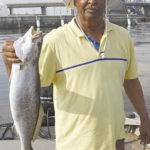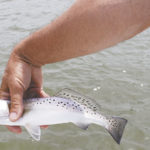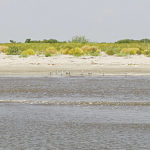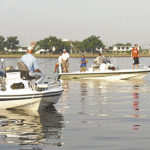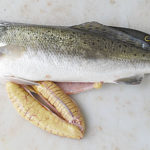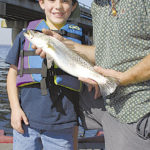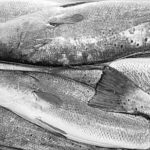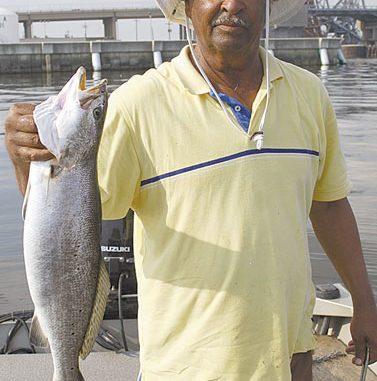
The winter was cold and very rainy. That’ll have an impact on this year’s speckled trout numbers.
My grandfather told me that people who rub crystal balls must sometimes eat glass. When one rubs the ball this year to get a prediction on the upcoming speckled trout season, he almost gets the feeling that it might be better to just eat the glass up front and give up on the rubbing. What has been a cold, wet winter has thrown something of a shadow over the 2010 speckled trout season.
In a nutshell, the fishery doesn’t seem to be in too bad shape, but the fishing may be pretty tough for the average angler, certainly for April, May and possibly June. But, depending on rainfall, both here and up the Mississippi River drainage, the outlook can skid for the worse or get significantly better.
And who can predict the weather?
Harry Blanchet, Marine Finfish Program manager with the Louisiana Department of Wildlife and Fisheries, said a lot of anglers are expressing concern that this winter may produce a repeat of the great freeze of 1989, when record cold temperatures over a long period froze lakes and bayous in coastal Louisiana. Then, when the white of the ice retreated, it was replaced by the white of countless numbers of dead fish bellies, many of them belonging to the state’s beloved speckled trout.
But this year is not a repeat of 1989, said Blanchet.
“It is one of the coldest winters on record in reference to air temperatures, but water temperatures haven’t been as cold as in 1989, when they dipped very low for short periods,” he said. “This year there were areas where water temperatures got as cold as then, but they didn’t stay cold as long, so the deeper waters that act as refuges for fish were not as affected.”
Just as important as water temperatures are for overwintering speckled trout, said Blanchet, are salinities. “Old Man River” will likely be really high this spring with all the rainfall and snowmelt in the Mississippi River drainage. And locally heavy rainfall has been enough to reduce salinities, both directly and through smaller rivers like the Calcasieu and Pearl.
But the big question, Blanchet said, is how long the Mississippi River will stay high.
“It normally falls by May, but if it stays up longer … .” He left the sentence unfinished.
“Winter is always a tough time for speckled fish,” he said. “Food is scarce, and they are forced to live off their reserves. Some fish will shift their food items to what is available. For example, redfish may have nothing in their guts but worm eels, not normally a major part of the species’ diet.
“We will get a higher number of ‘funky fish’ with emaciated and deformed bodies, skin and muscle damage and eroded fins. Specks will also have a higher incidence of parasitic and fungal infections.”
What does this have to do with making predictions?
In a worst-case scenario, Blanchet explained, we could get a big kill, like we had in 1989, followed by reduced catches the next year and then a strong rebound the year after. But we didn’t see anything like the mortality of 1989 this winter.
The cold temperatures and low salinities of this year will more likely result in a short-term displacement of trout populations than in high mortalities. Biological sampling showed that the survivors in 1989, as well as speckled trout in other cold winters, shifted their center of abundance to the lower parts of the estuaries and offshore. Populations didn’t recover their normal distribution until after May.
Since most of the recreational fishery from April to June occurs inside of the estuaries, anglers will probably have to travel farther, burn more gas and fish in unfamiliar waters to dependably make good catches.
Sampling numbers for 2009 were pretty near the norm, said Blanchet.
“Everything fell within 15 percent of the long-term average,” he said. “But that was before the effects of this winter. With this year’s cold and wet conditions, I would hate to stick my neck out on making projections of harvestable fish this year from our seine samples of juvenile specks last year.
“But remember, a bad year in Louisiana is a good year anywhere else.”
Area predictions
Perhaps a little unfairly, considering the environmental conditions this year, Louisiana Sportsman nudged Blanchet into providing predictions for the upcoming speckled trout season. In answering our request, Blanchet relied heavily on information provided by LDWF’s coastal area study leaders, who he called the “head honchos” of the seven coastal areas.
“They are most familiar with the conditions in their areas,” he said.
Here is what they had to say about the 2010 trout season:
• Area 1 (Lakes Pontchartrain and Borgne south to the MRGO)
Brian Lezina’s quote, provided by Blanchet, was direct if not comforting: “If trout ‘availability’ remains similar to now, the redfish will start getting nervous.”
Ouch!
By “availability” Lezina meant that speckled trout will be harder to find and catch because they will shift location to deeper and warmer waters and reduce their activity levels. He went on to say that salinities and temperatures in his study area are well below the previous decade’s average, and have been since September.
As if that news weren’t enough, he added that the conditions could slow the growth of overwintering speckled trout, particularly smaller fish, which may take longer to grow to harvestable size.
Conditions could get worse, he noted. Record precipitation may mean another Bonnet Carre Spillway opening, which could displace speckled trout from Lake Pontchartrain all the way to Lake Borgne. Prevailing winds would also push high Mississippi River discharges from the mouth of the river back into the area. And not to be overlooked if local rainfall keeps up are the discharges of fresh water from the Pearl and the rivers draining the Florida parishes.
Although Blanchet wouldn’t say much about the effect of the 2009 closure of the Mississippi River Gulf Outlet (MRGO) because he didn’t have data to support a comment, he noted that he recognized some effects may occur. For decades, the MRGO has been blamed (or credited, depending on one’s point of view) for increasing salinities in the lake.
“We are re-plumbing the whole coastal zone,” Blanchet said. “The effects of this will depend on the locality and extent of the projects completed. The projects are necessary to sustain wetlands — we need wetlands for fisheries — but we will have to expect some effects from them.”
• Area 2 (MRGO to the Mississippi River)
Blanchet said that because this area is closer to the birdfoot delta than Area 1, fishing success will be heavily dependent on what happens with the Mississippi River in the next few months.
“This may be the area most strongly influenced by fish displacement, and fish will travel farther. More of the area is in open sounds and less is in marshes than for other areas of the state.
Study leader Keith Ibos offered the observation that so far this year, the weather has been difficult and fishing pressure has been low. He noted that area biologists have been seeing some speckled trout in their sampling gear, but the high river and muddy waters have made things difficult for recreational anglers.
Because the system is so dynamic and things can change quickly, Blanchet provided some direct advice for people who fish the area, suggesting that they should stay in close communication with information sources such as marinas, bait shops, tackle stores, other anglers and fishing websites.
“Things can change rapidly in this area, including for good angling,” he said.
• Area 3 (Barataria Basin)
Blanchet opened discussion on this area by saying that the Barataria Basin probably has more anglers per square mile of speckled trout habitat than any other place in the state.
Area biologist Jason Adriance reported that in this area they have compared gill-net data with angler catches since 2001, and found a good correlation between the two. He noted that the smallest mesh-size panel in the LDWF multipanel gill nets were a good indicator of recruitment (growth of fish into a harvestable size range) and that the other four mesh sizes were good indices of availability (numbers of fish of catchable size at a particular point in time).
But he warned that if the smallest mesh size is indeed a good indicator of recruitment, then perhaps anglers in this system should expect lower trout numbers in 2010 than what the average has been since 2001.
But, he added, the average size of “school trout” may be larger than normal.
“If trout fared well during the freeze, overall fishing should be better than it was in the early 2000s,” he said.
Blanchet explained the apparent contradiction. From 2000 to 2005, the Barataria system had mediocre trout years. Then Hurricane Katrina hit in 2005, and 2006 was a “gangbuster” year.
“There were speckled trout everywhere,” he said.
They were called “Katrina trout.”
The phenomenon, he said was probably due to the massive storm moving high salinity water inshore, followed by months of dry weather and greatly reduced fishing pressure over the winter.
“Everybody was putting roofs on their houses instead of fishing,” he said.
Adriance bravely went farther out on a limb with his predictions, noting that despite increases in catches in the department’s sampling nets, larger speckled trout may still not be available in any quantity. The reasons he gave for this prediction were 1) continued poor recruitment, 2) degrading marsh conditions due to coastal erosion and 3) increased freshwater diversions.
Lest he sound to negative, he noted that even given all this, many traditional hotspots, including the passes and beaches, will still produce good catches.
• Area 4 (Bayou Lafourche west to Grand Caillou)
This area is the one with the highest salinities in the state, and is the least affected by river discharges. Still, study leader Vince Guillory noted that based both on gill net samples and surveys of anglers’ catches, the abundance of speckled trout is below average.
“Water temperatures and salinities are below average,” he said. “Neither is conducive to spotted seatrout abundance.”
He noted that anticipated high Mississippi River discharges will reduce salinities further and could negatively affect spawning.
His assessment was brief and direct.
“Catches will probably be below average in 2010 and may be suppressed in the future as the 2010 year-class enters the fishery,” he said.
• Area 5 (Grand Caillou west to the Atchafalaya River)
Steve Hein, study leader for this area, said that from the hurricane hits and near misses of the mid-2000s extending up until October 2009 the availability and numbers of speckled trout have been “reasonably strong.”
He stated flatly that limits of small to medium-sized trout were abundant inshore and nearshore, and “great catches of larger fish” were made from offshore structures and platforms.
But things changed.
“Since October, we have received numerous complaints of fish being ‘missing’ from their traditional wintering grounds,” he said.
The culprit, Hein suspects, is low salinities resulting from a wet winter, especially in the western part of the area nearest the Atchafalaya River.
He added that the recently completed Lake Mechant Land Bridge coastal restoration project is expected to reduce salinities in that area over the long term.
His prediction was that spring and early summer speckled trout fishing will probably be “sub-par” compared to the previous year, especially north and west of Bayou Grand Caillou. Unless conditions change quickly, he said, the most success will go to anglers who fish in the eastern part of the area, at offshore structures and wrecks and on the beaches toward the east.
• Area 6 (Atchafalaya River west to the western shore of Vermilion Bay)
As fishermen in this area well know, angling success is closely tied to discharges of sediment-laden fresh water from the mouth of the Atchafalaya River, the Wax Lake Outlet and The Jaws. Biologist Paul Cook said when the Atchafalaya River gauge at Butte La Rose is at 8 feet or less, anglers can expect to see good fishing in the bays and on nearshore reefs.
Flooding from January to March, he added, has little effect on the trout fishery, while river flow from April through June is highly significant. Low river discharges allow warmer saline waters to intrude and create favorable fishing conditions for both prey species and sight feeders like speckled trout.
He said that the 2009 trout season in the Vermilion area was “fair, at best” and deteriorated early.
“The chances of the river falling in March to May to more conducive levels are unlikely,” he said.
The long-term picture for the area is rosier, according to Hein. All indications are that trout populations are healthy, and the number of businesses that cater to trout anglers is increasing. Although fishing conditions are difficult now, if they improve, anglers can expect to see fish on their old haunts.
• Area 7 (Vermilion Bay’s western shore west to the Texas state line)
This area, the most important fishing destination of which is Calcasieu Lake, offers a brighter outlook for 2009 than most other areas. According to biologists Mike Harbison and Peyton Caigle, gill net and trammel net samples in 2009 were above the long-term average.
Even more interesting was that sample numbers of speckled trout over 20 inches long increased in both Turner’s Bay and northern West Cove. And early data this year shows good numbers of speckled trout are available.
Blanchet offered some perspective.
“The thing to remember is that the Calcasieu and Sabine lakes were strongly influenced by Hurricane Ike and got that post-hurricane effect,” he said. “It usually lasts about a year, so I don’t know how much effect we will see this year.”
According to the biologists, the outlook for 2010 is for lower salinities and temperatures than what existed in 2009, but they will still be near the long-term average. Calcasieu Lake, they noted, has remained one of the most productive areas in the state in catches of speckled trout.
